🧭 Toyama Itinerary: 1–5 Day Travel Guide to Japan’s Underrated Gem
Why Toyama Should Be on Every Traveler’s Radar
Plan the perfect Toyama itinerary. From snow walls and firefly squid to samurai towns and sushi, you’ll see why this coastal prefecture should top your Japan bucket list.
Table of Contents
ToggleThis guide walks you through a full 1–5 day Toyama itinerary: crafted for backpackers, explorers, solo travelers, and Japan fanatics who crave something different. By the end, you’ll have your route, meals, and must-see stops mapped out, plus a deeper love for this quiet coastal mountainous gem.
Hey, I’m William, and I’ve been living in Toyama for a few years now. I never intended on staying, but the captivating nature kept me in. I’d love for you to see this often overlooked gem, so here’s what I think is the best itinerary for Toyama!
If you have any questions, feel free to reach out on Instagram @barefoot.surfer or with an email.
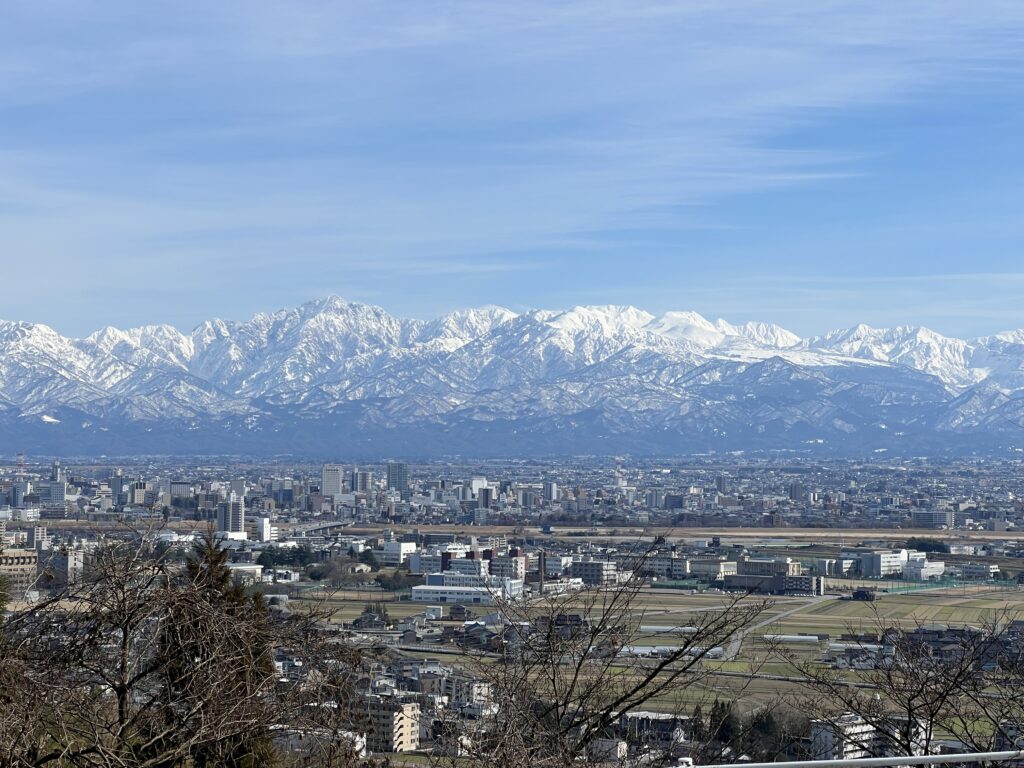
Is Toyama worth visiting
If you’re skipping Toyama, you’re missing Japan’s best-kept secret. This isn’t Kyoto’s crowds or Tokyo’s neon flash. Toyama is raw, quiet, scenic, and wildly authentic. A perfect balance of coast and mountain. Culture and cuisine. Nature and neighborhood charm.
What is Toyama Known for
Toyama has some of Japan’s best seafood. It’s a prefecture of nature, close enough to Tokyo, and right next to Kanazawa, making it very accessible by bullet train. It’s a nature lover’s getaway from the big cities, with mountains for hiking, skiing / snowboarding, and Japan’s tallest waterfall.
For other things in Toyama read the Toyama Guide
Best time to Visit Toyama Japan
I always recommend April for the Cherry Blossoms, Tulip Festival, Firefly Squid, Snow Wall, all being available in April. September is also optimal with the best festival in Japan, Yatsuo Kaze no Obon happening at the beginning of September, as well as Koyo, the fall colors arriving with the cool weather hiking.
Choose when to visit by the best season to visit Toyama
🗓️ How Many Days in Toyama?
1 Day in Toyama: Perfect for a Day Trip
Can you visit Toyama in One Day
Yes, Toyama is a great day trip from Kanazawa or Takayama. It could be your seafood escape, or nature wonderland while you get away from the more touristy destinations. But, if you want to truly experience it, I would recommend a little more time.
2–3 Days in Toyama: The Ideal Weekend Itinerary
A weekend trip is just enough to taste Toyama’s nature and culture. You can explore the city and try the prefecture’s specialties such as firefly squid, white shrimp, and black ramen. It also gives you enough time to either explore the historic town of Gokayama (a non-touristy alternative to Shirakawago), or take a day-trip up Tateyama Kurobe Alpine Route.
4–5 Days in Toyama: Full Exploration of the Region
This is the dream. If you really enjoy nature and seafood, this is my recommendation. You can explore the mountains, see the seafood markets, and hopefully time it right to visit during a festival. If you get bored, Kanazawa is just 30 minutes away as well as Takayama being 2 hours away, both amazing day trips from Toyama.
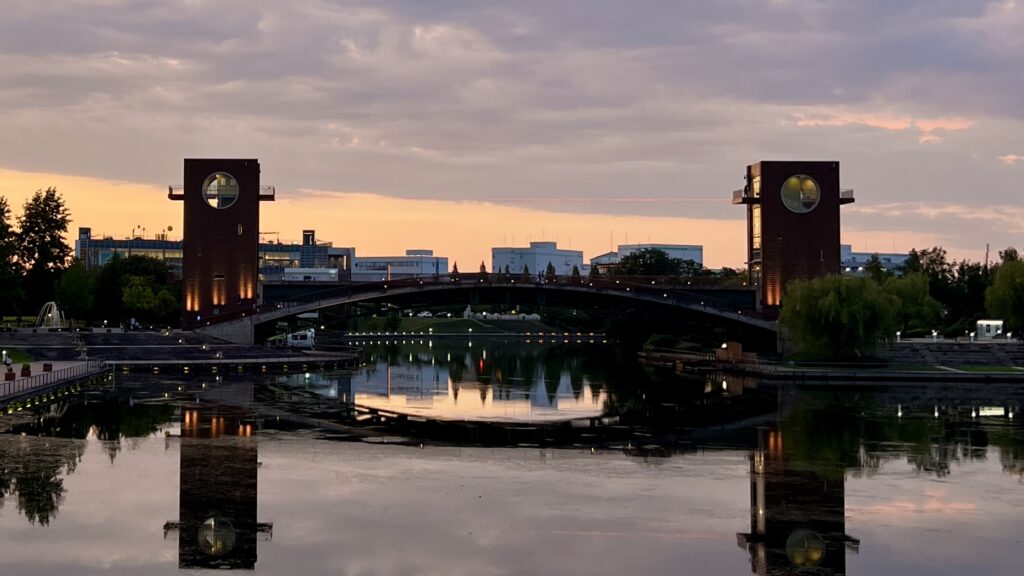
🚅 How to Get to Toyama
From Tokyo: Toyama by Shinkansen
The Hokuriku Shinkansen gets you there in under 2.5 hours. If you want to save some money, there are night busses available, sometimes for 1/4th of the cost.
From Kanazawa, Kyoto, Takayama or Nagoya
Easy local trains or buses!
-Kanazawa is just 25 minutes away by bullet train
-Takayama is 2 hours by local train
-Nagoya is a 3-4 hour bus ride away
-Kyoto and Osaka are about a 3-4 hour train ride away
Toyama Airport Access
Direct flights to/from Tokyo, Sapporo, Fukuoka: compact and convenient.
Toyama is accessible by airport from Tokyo and Sapporo as major hubs, but I would recommend the train if you are on the main island of Honshu area.
🗺️ The Perfect Toyama Itinerary by Day
🧭 Toyama Itinerary: 1–5 Day Travel Guide to Japan’s Hidden Gem
🏙️ Day 1 – Toyama City: Culture & Coastal Flavor
You arrive the night before. You booked a clean, cozy hotel right next to Toyama Station for under ¥7,000. Perfect.
You wake up early. The air is fresh and a little cold. You’re excited. You’re in a city that most people overlook, and that’s exactly why it feels like yours.
First stop: Kansui Park. A ten-minute walk brings you to the most scenic Starbucks in Japan. You sit on the terrace with a steaming cup and views of Tenmon-kyo Bridge. You sip. The water glimmers. Locals jog past. Time slows down.
Next: Toyama Castle Park. A 25-minute walk (or tram ride) takes you to a quiet park with moats, sakura trees, and a modest yet charming museum inside the reconstructed castle tower.
By noon, Sogawa. You stroll into a covered shopping street and cultural district. You stop at the Toyama Glass Art Museum, located inside the iconic Toyama Library building. Inside, you wander through dazzling exhibits where sunlight refracts off crystal and color.
Lunchtime. You pick from:
- Toyama Bay Sushi
- Black ramen
- A juicy wagyu burger from Shogun Burger
You go for the sushi. And you don’t regret it.
Afternoon: Iwasehama. You catch the tram to this peaceful port district. Meiji-era buildings line the quiet streets. You sip craft beer at Kobo Brewery until their 6 p.m. closing.
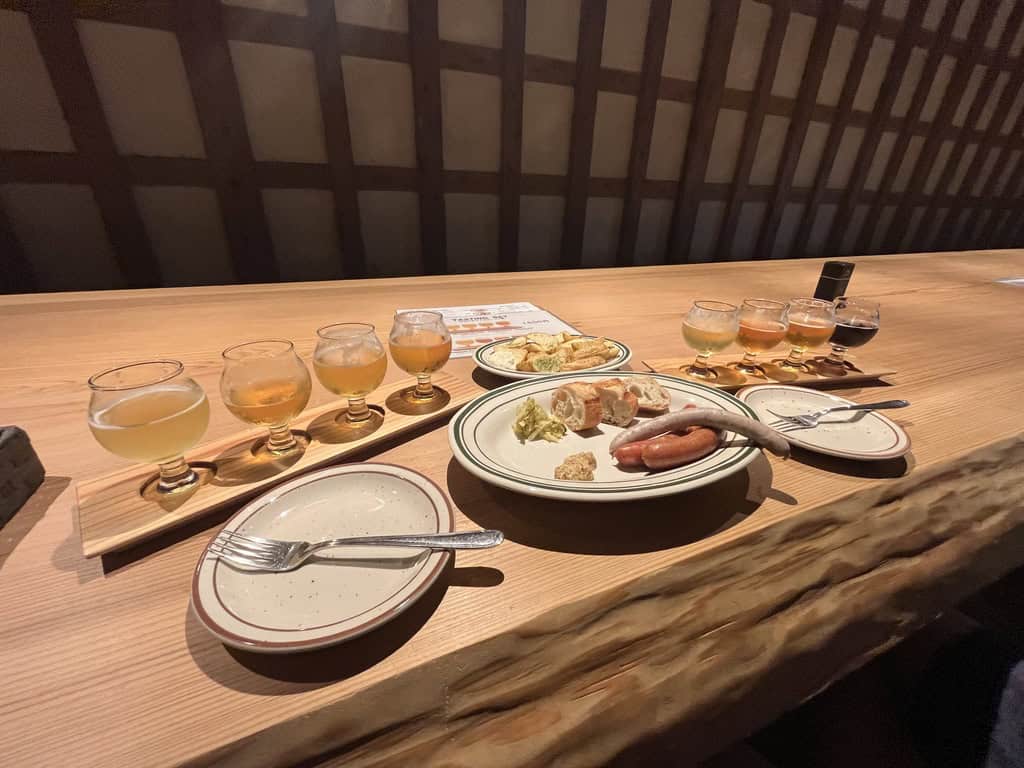
Dinner: Back near the station. This time it’s black ramen. Salty, intense, unforgettable.
You take a nighttime walk past the castle again. The lights glow. The park is quiet. You feel like you’ve found something nobody else has.
Locations Mentioned:
Toyama Castle: A reconstructed 16th-century castle set in a peaceful park, with a small museum showcasing the history of the region and samurai-era Toyama. → [Read more]
Toyama Glass Art Museum: Located in the stunning TOYAMA Kirari building, this museum features both international and Japanese glass art. Part gallery, part design marvel. → [Read more]
Kansui Park: A scenic, waterfront green space with running paths and a famous Starbucks known for its architectural design and views of Tenmon-kyo Bridge. → [Read more]
Toyama Bay Sushi: A local specialty that features ultra-fresh seasonal seafood caught in Toyama Bay, prepared and served the same day. Famous for its delicate flavors. → [Read more: Toyama Bay Seafood]
Toyama Black Ramen: A bold regional ramen made with dark soy broth, thick noodles, and salty pork slices. Originally designed as a post-work meal for laborers. → [Read more: Toyama Black Ramen]
Iwasehama: Toyama’s old port district, home to traditional wooden buildings, quiet streets, and Kobo Brewery, one of the city’s few craft beer spots. Great for an afternoon stroll. → [Read more]
🏞️ Day 2 – Tateyama Kurobe Alpine Route: Snow Walls, Sky Bridges, and Mountain Awe
You wake up early again, before the sun fully rises. There’s a different kind of energy today; you’re not just exploring a city anymore. You’re heading into Japan’s Northern Alps.
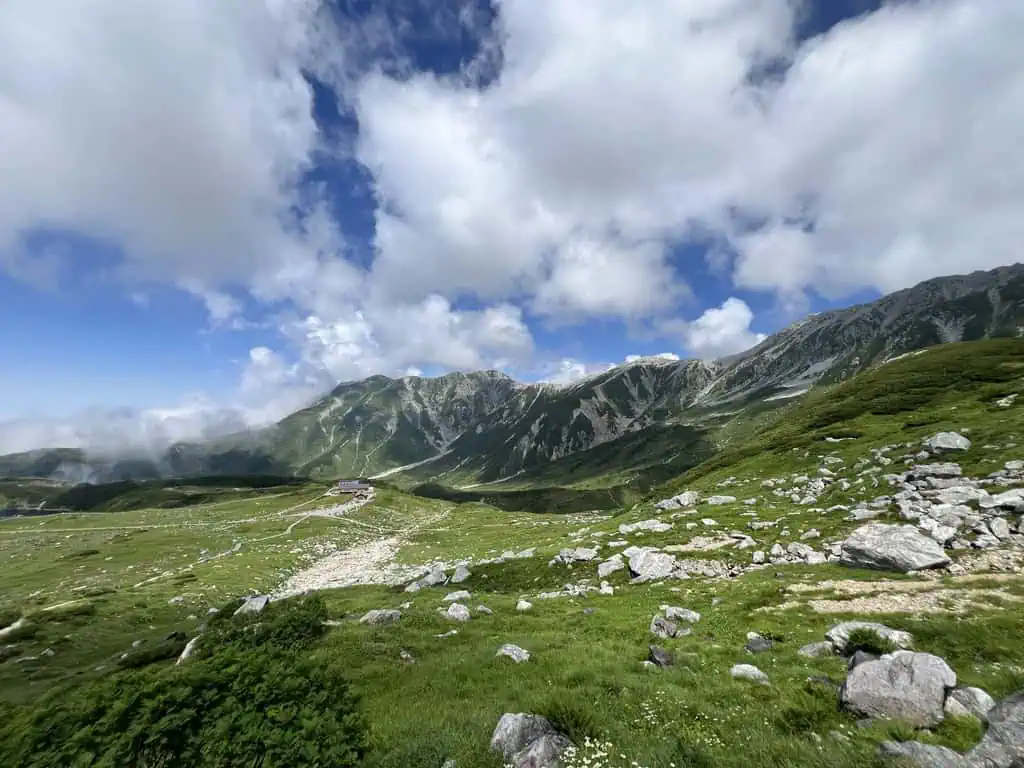
Grab a quick breakfast from the konbini next to your hotel. Rice ball, coffee, maybe a sweet potato pastry. You’re going to need the fuel.
I’d recommend Toyama’s Masu no Sushi! It’s a very vinegar flavored slab of sushi that’s the size of an onigiri rice ball. They’re available in many convenience stores in Toyama, but not all of them.
🚞 How to Get to Tateyama from Toyama
From Toyama Station, take the Toyama Chiho Railway to Tateyama Station.
⏱️ Time: About 1 hour
💴 Cost: Around ¥1,200 one way
The train begins to climb. You pass through rice paddies, sleepy towns, and pine forests blanketed in mist. By the time you arrive at Tateyama Station, you already feel the altitude creeping in. The air is colder. Sharper. Cleaner. You take a deep breath. It’s pure.
🏔️ First Stop: Tateyama Cable Car to Bijodaira
Hop on the Tateyama Cable Car, which climbs steeply through the forested gorge.
⏱️ 7 minutes
🌲 You’re in the thick of cedar forests and jagged cliffs.
You land at Bijodaira. If it’s autumn, the leaves explode in reds and yellows. In spring, it’s still chilly and green. You pause here only briefly, knowing what’s coming next.
🚌 Next: Highland Bus to Murodo – The Roof of the Route
This is the real ascent.
⏱️ 50 minutes by Highland Bus
🎫 Covered with the Tateyama Kurobe Option Ticket (or Alpine Route pass)
🧊 April–June: The Snow Wall Corridor
🍂 October: Flaming autumn leaves hugging the cliffs
As the bus winds up the mountain, everyone’s quiet. It’s not silence… it’s reverence. The landscape unfolds like a painting: mountain peaks streaked with snow, alpine plateaus rising out of the clouds.
Suddenly, 15-meter snow walls appear on both sides. You’ve arrived.
❄️ Yuki-no-Otani (Snow Wall Walk)
At Murodo Station, you step out into another world.
The Yuki-no-Otani Snow Wall is at its best in April and May, towering as high as a five-story building. You walk along the open-air path, bundled up in your jacket and scarf, camera in hand. Everyone around you is quiet, jaws open.
It’s like stepping into a white canyon: pure, still, dramatic.
You feel small. And that’s the point.
→ [Read more: Toyama Snow Wall: World’s tallest snow wall]
🍱 Lunch in Murodo
There’s a cozy cafeteria-style restaurant near the Murodo terminal. Get the hot curry rice, or a bowl of warm soba. Prices are slightly inflated, but the view? Worth every yen.
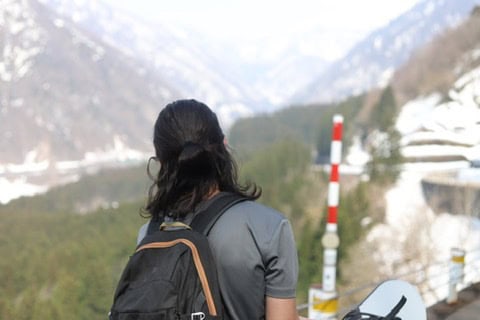
You sit by the window, sipping tea, staring into cloud-covered ridges. The world feels far away.
🏞️ Murodo Highland Trails
After lunch, take a short walk on the Mikurigaike Pond loop trail.
⏱️ Around 45 minutes
🩵 Still partially frozen in spring, glowing blue in summer.
This is the heart of the Tateyama range. You might spot ptarmigans, or even a fox, if you’re lucky.
The volcanic steam vents remind you this place is alive. It smells faintly of sulfur, and the terrain feels both sacred and surreal.
🚠 Ropeways, Tunnels & Final Views
If you have time and energy, continue along the Alpine Route toward Daikanbo and Kurobedaira via:
- Tateyama Tunnel Trolley Bus
- Tateyama Ropeway (1.7 km—the longest single-span ropeway in Japan)
- Kurobe Cable Car
Each one reveals a different angle of this mountain world—ice valleys, jagged cliffs, and surreal ridgelines.
If you’re doing a round-trip from Toyama, head back to Murodo and reverse the route in the afternoon. By 6–7 p.m., you’re back in your hotel, tired, windblown, and lit up with everything you just saw.
Dinner? Something warm and hearty near Toyama Station again. I’d try a bowl of Deep Fried White Shrimp in the station.
The Best Western Food in Toyama
-Shiny Mountain: for an Irish Pub that has Fish and Chips and great Guiness
-Cinquento Uno: for a French Restaurant and Wine Bar
Locations Mentioned:
Tateyama Kurobe Alpine Route
A legendary mountain route that includes buses, ropeways, and cable cars between Toyama and Nagano, offering seasonal highlights like snow walls, fall foliage, and panoramic vistas.
→ [Read more]
Yuki-no-Otani (Snow Wall)
A 15+ meter tall wall of snow lining the road near Murodo Station, accessible from April to June. An iconic photo spot in spring.
→ [Read more: Toyama Snow Wall: World’s tallest snow wall]
Murodo Highland
The highest accessible area of the route at 2,450 meters. Includes trails, volcanic terrain, and mountain lodges.
→ [Read more]
Mikurigaike Pond
A volcanic alpine pond near Murodo, reflecting the peaks of the Tateyama range. Easily walkable loop trail.
→ [Read more]
Tateyama Ropeway
A scenic aerial lift connecting Daikanbo and Kurobedaira, known for its panoramic mountain views and single-span design.
→ [Read more]
🏯 Day 3 – Takaoka & Gokayama: Timeless Craft and Hidden Heritage
You wake up early and catch a local train to Takaoka from Toyama Station, just 20 minutes. You grab a light breakfast from the station bakery and sip hot coffee as the train glides past suburbs and quiet fields. You feel like you’re heading somewhere special. And you are.
First stop: The Great Buddha of Takaoka.
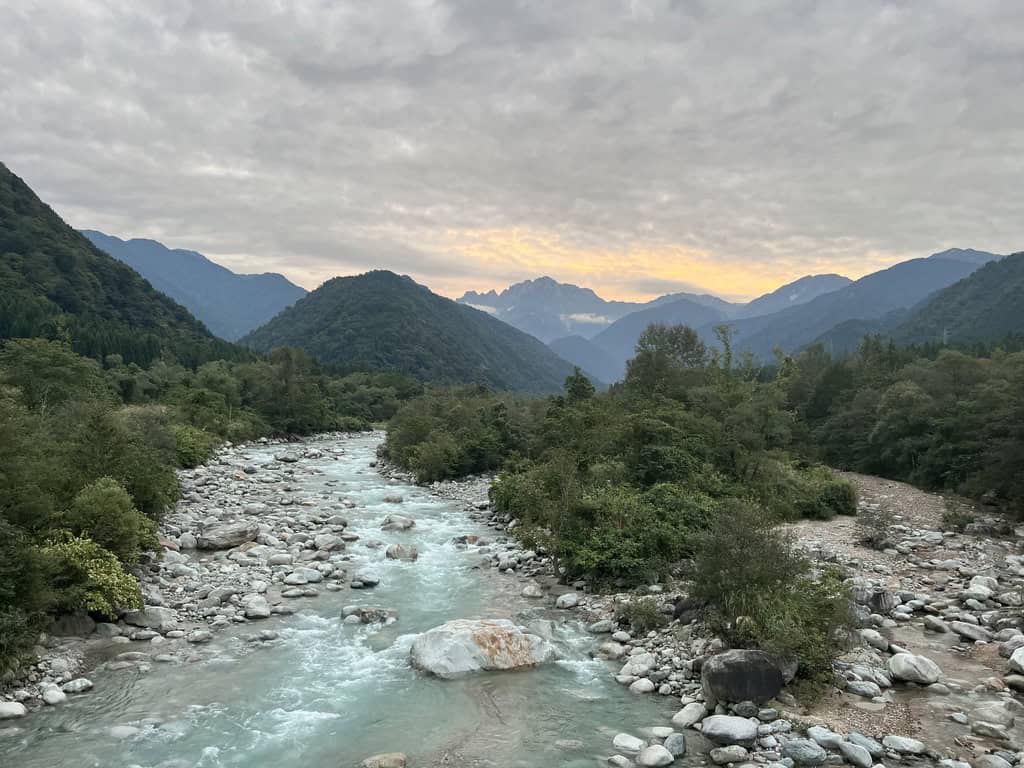
A 15-minute walk from the station. As you approach, the towering bronze statue emerges above rooftops. It’s over 15 meters tall, serene, and full of presence. You stand at its feet and feel small. A little humbled. Local legend calls it one of Japan’s Three Great Buddhas and it’s easy to see why.
But to be completely honest, it doesn’t feel so spectacular. I’d compare it to the one in Kamakura near Tokyo, but it’s right in the middle of a street. It’s worth a quick stop though.
Next, you stroll into the metalworking district. This town has been crafting copper and tin for over 400 years. The air smells faintly metallic. Inside a small workshop, you join a tin-smithing experience. You hammer your own little dish. It’s meditative, rhythmic, and by the end, you’ve made a keepsake with your own hands.
Lunchtime. You grab a set meal at a local café, fresh river fish, miso soup, and pickled vegetables. Simple. Pure. It tastes like countryside Japan.
After lunch, it’s time for the highlight: Gokayama.
From Takaoka Station, you take a bus into the mountains (1 hour 40 minutes). The road winds upward. Trees thicken. Valleys deepen. You arrive in Ainokura, a UNESCO World Heritage site known for its steep thatched roofs, or gassho-zukuri. The village is almost too perfect. No wires. No billboards. Just a few wooden homes, mossy roofs, and the gentle sounds of wind and water.
You walk between the houses. Rice fields ripple beside you. A local tells you the village has stood here for over 250 years. You hike up a small hill for the postcard view — the whole valley below like a diorama. You take a deep breath. It’s clean. Ancient. Sacred.
You linger until golden hour. Then the return journey to Toyama. Tired but amazed.
Locations Mentioned:
Takaoka Daibutsu:
One of Japan’s Three Great Buddhas, this massive bronze statue towers above Takaoka’s center and represents centuries of craftsmanship. → [Read more]
Takaoka Metal Crafts:
400+ years of tin and copperworking heritage — you can see, learn, and even join a workshop. → [Read more]
Gokayama Villages:
UNESCO-protected hamlets with traditional gassho-zukuri farmhouses tucked into mountain valleys. → [Read more: Gokayama: Toyama’s hidden UNESCO Village]
🌊 Day 4 – Seafood, Shrines, and Seaside Serenity
You’ve explored the city, the mountains: now it’s time to taste the coast.
You start with an early tram ride to Iwasehama, the historic port town north of Toyama. It takes about 25 minutes. The morning sea breeze hits your skin the moment you step off. Salty. Crisp. Real.
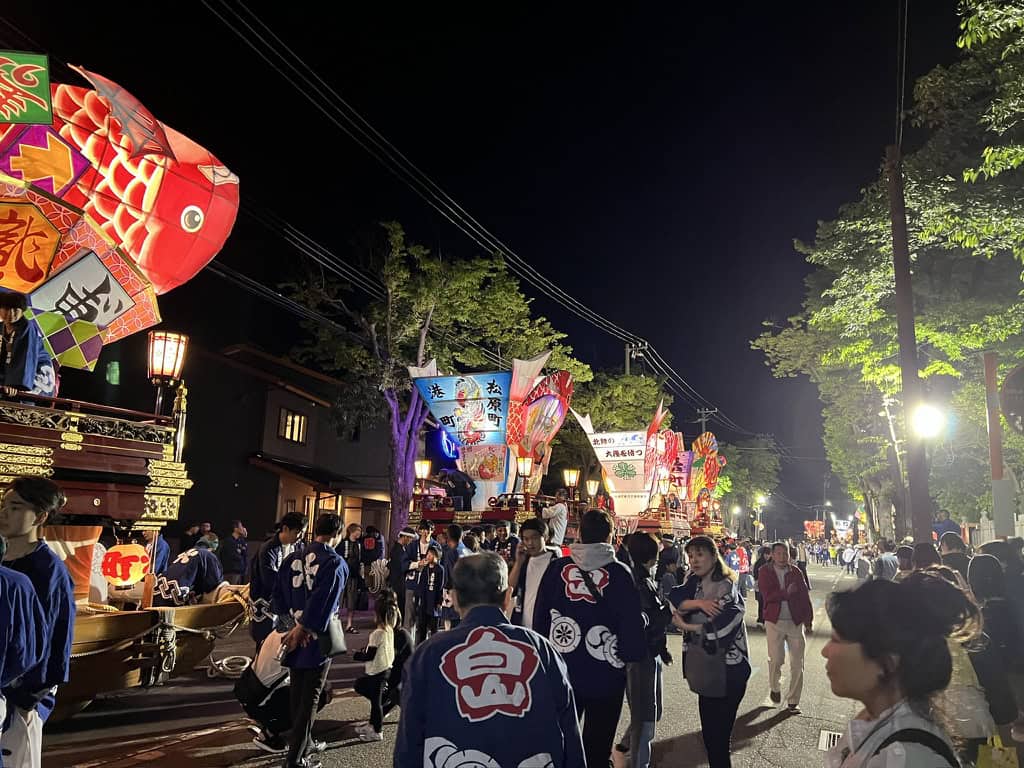
Nicknamed “fighting festival” because the floats clash into each other in a big game of tug-of-war!
First, you walk through the Iwase Historical District: narrow streets, restored merchant houses, and sea-worn facades. You stop by Kobo Brewery again, this time for a quick souvenir. Next door, a retro coffee shop serves a nostalgic blend with soft jazz playing in the background.
You grab a seafood breakfast set; Toyama Bay Sushi, packed with white shrimp and squid that taste like they were caught 10 minutes ago.
From here, you take the local train east to Namerikawa (30 minutes), home of the Hotaruika Museum. You’re here for one reason: firefly squid. These tiny glowing creatures light up Toyama Bay every spring. Inside the museum, you learn about their life cycle, watch videos of the underwater glow, and if you’re lucky, catch a live tank display. It feels like watching starlight move.
Lunchtime: fresh-caught shiroebi (white shrimp) tempura served at the café next door. Sweet, delicate, lightly fried. You’ll never look at shrimp the same way.
Afternoon: You head to Toyama Port Observation Tower, a short ride from Namerikawa. From the top, the bay stretches endlessly. If it’s clear, the Tateyama mountain range floats above the horizon like a dream.
You return to the city with salt in your hair and seafood in your soul. Dinner is your choice: Local cuisine, a supermarket bento. Either way, you earned it.
Locations Mentioned:
Iwasehama:
Charming coastal neighborhood with Meiji-era buildings, local breweries, and seaside charm. → [Read more]
Toyama Bay Seafood:
Fresh catch from the deep bay — especially firefly squid and white shrimp. → [Read more: Toyama Bay Seafood]
Hotaruika Museum:
Interactive museum in Namerikawa dedicated to Toyama’s glowing firefly squid. → [Read more: Firefly Squid: Toyama’s Glowing Tasty Secret]
Shiroebi (White Shrimp):
A delicacy of Toyama Bay, known for its sweetness and transparency. → [Read more]
Toyama Port Observation Deck:
Offers sweeping views of the bay, sometimes reflecting the Tateyama peaks. → [Read more]
🌲 Day 5 – Waterfalls, Onsen & Wilderness
It’s your final full day. And today, nature’s taking over.
You leave early, grab a bento, pack water, and catch a bus from Toyama Station to Shomyo Falls (90 minutes). The road follows the river into the mountains. You feel the altitude rise. Trees become giants. Water thunders in the distance.
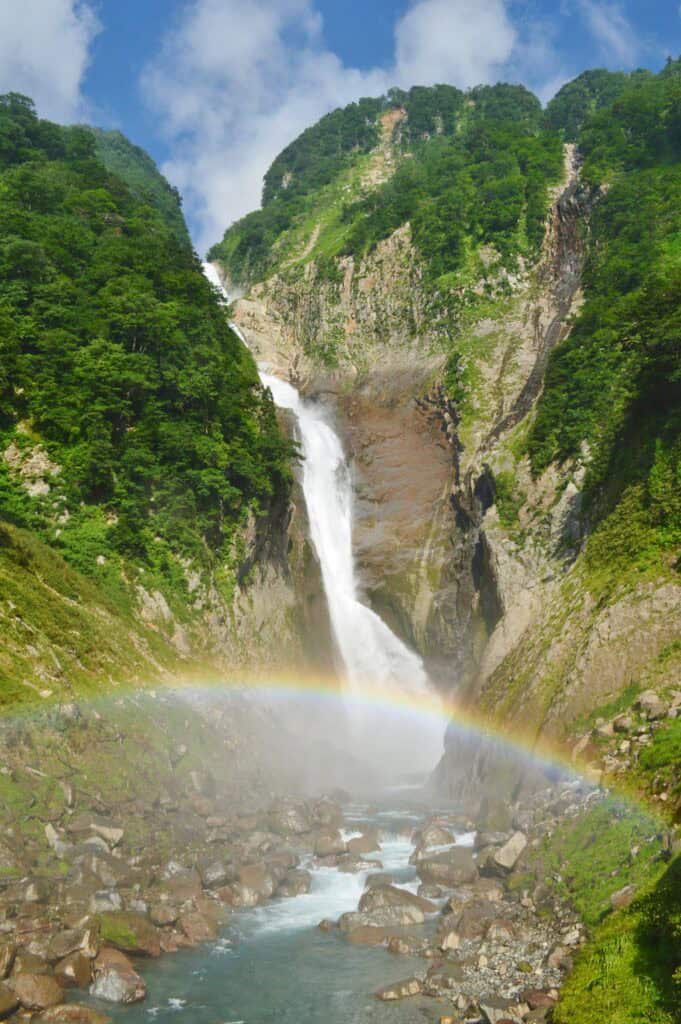
You reach Shomyodaira Parking Lot, then begin the 30-minute walk to the falls. The trail is paved, easy to follow, and lined with ferns. Along the way, you see educational signs and even a rest station with videos on the geology of the area.
Then, suddenly, the roar.
Shomyo Falls.
Japan’s tallest waterfall: 350 meters of unbroken drop. You feel the mist hit your face as you approach. Rainbows form in the spray. It’s loud. Alive. Epic.
You stay a while. Watch. Breathe.
From here, you can either hike around for the rest of the day in the hills and enjoy the nature, or head back to the station and catch the train to Unazuki Onsen (1.5 hours), tucked in the lush mountains near Kurobe. The onsen town is cozy, traditional, and slow-paced. You soak your feet in a free ashiyu (foot bath) outside the station. Then check into a ryokan for the night.
Your final dinner is kaiseki: a multi-course meal with local mountain vegetables, river fish, and subtle flavors.
You soak in the hot spring bath. Outside, the stars begin to show. You’ve never felt more relaxed.
Locations Mentioned:
Shomyo Falls:
At 350 meters, the tallest waterfall in Japan. A must-visit natural wonder with seasonal variation. → [Read more: Shomyo Falls: Japan’s Tallest Waterfall and Toyama’s best Kept Sectret]
Unazuki Onsen:
Charming hot spring village in the Kurobe area — ideal for a final night of rest and reflection. → [Read more]
Kurobe Gorge:
One of Japan’s most scenic rail journeys, though best explored in autumn or summer. → [Read more]
🛌 Where to Stay in Toyama
Keywords: best hotels in toyama, ryokan toyama, toyama hotel near station
Best hotels in Toyama
- Budget: Guesthouses & hostels near Toyama Station
- Mid-range: Daiwa Roynet, Dormy Inn
Ryokan Toyama
They’ll be at Unazuki Onsen
Toyama Hotel near Station
The Hilton Double Tree is right there in front of the station around the nightlife of downtown without being too loud.
🗺️ Toyama Attractions Map: Itinerary Stops
🎒 Toyama Backpacking Tips
Keywords: backpacking toyama, japan budget itinerary, solo travel toyama
- Use the Toyama Chiho Railway Pass
- Shop at local marts for lunch; early morning for seafood
- Most attractions walkable or short train rides
- Weather changes fast: bring layers
❓ FAQs: Toyama Itinerary Planning
Can I combine Toyama with Kanazawa?
Yes, it’s only 25 minutes away. Perfect combo.
When does it snow in Toyama?
December to March, with snow wall access starting mid-April.
Is Toyama good for solo travelers?
Yes, it’s safe, compact, and has friendly locals.
Author
William @ Barefoot Surfer
I’m William, the writer behind Barefoot Surfer: a blog about honest, no-BS backpacking through Japan and Southeast Asia. I left behind the typical career path to backpack for 8 months. Currently living in Toyama, Japan. I've traveled on $500 a month. From hitchhiking across islands to sleeping in train stations, I share practical tips and personal stories for travelers who value freedom over comfort and truth over fluff.
Pingback: Toyama Glass Art Museum Guide – Award-Winning Architecture